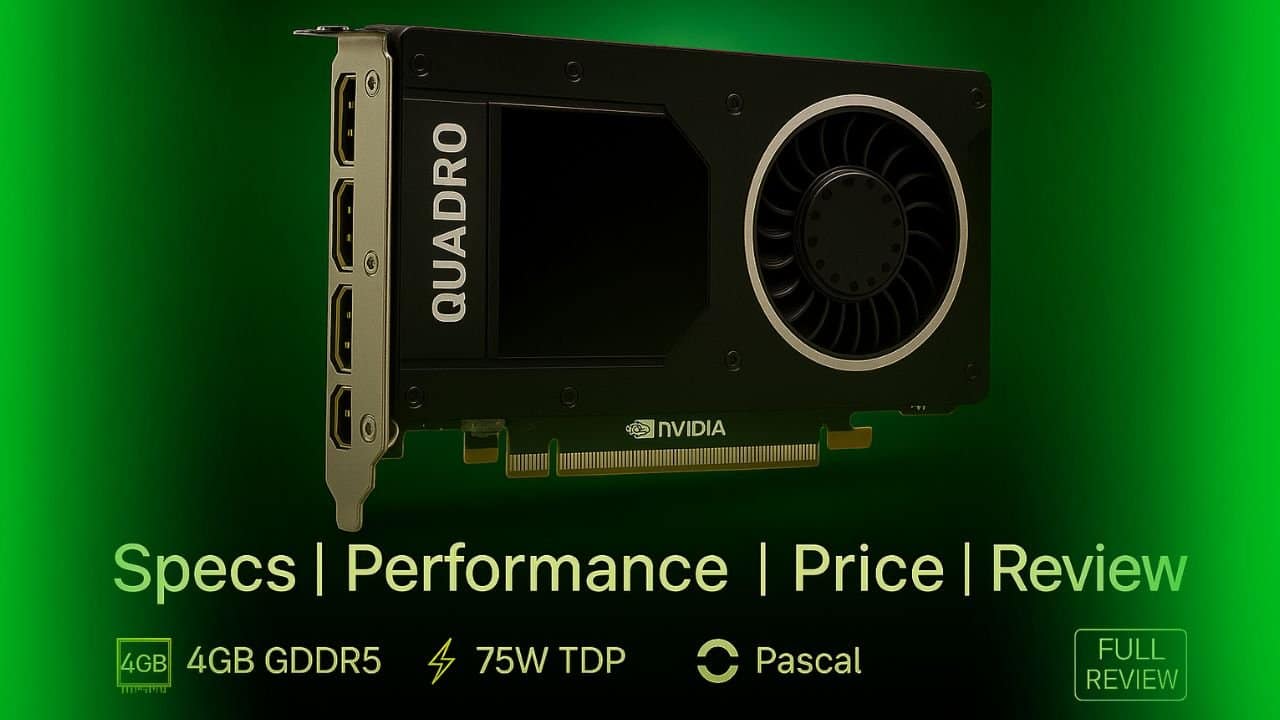Table of Contents
Introduce The Quadro M2000
A budget workstation GPU that still has a little life left.
When we talk about graphics cards, most people immediately think of gaming GPUs like GTX, RTX, or Radeon. But there’s another category built not for gaming, but for work, these are called workstation GPUs. NVIDIA Quadro is one of the most famous families in this space.
Back in 2016, NVIDIA released the Quadro M2000, a mid-range professional card based on the Pascal architecture. At the time, it was aimed at engineers, designers, 3D artists, and video editors who needed a stable and certified card for apps like AutoCAD, SolidWorks, and 3ds Max.
Now, almost a decade later, we ask: is the Quadro M2000 still worth buying in 2025? Let’s dive into a detailed but easy breakdown.
Specifications
| Spec | Detail | What it means |
|---|---|---|
| GPU Architecture | Pascal | Same family as GTX 10-series (like GTX 1060). |
| CUDA Cores | 768 | Small processors inside the card that do the math for graphics. |
| Memory (VRAM) | 4 GB GDDR5 | Stores 3D data, textures, and video frames. |
| Memory Bus | 128-bit | Decides how fast data moves in and out of memory. |
| Power (TDP) | 75 W | Low power use, no extra power cable needed. |
| Outputs | 4× DisplayPort 1.2 | Can run up to four monitors. |
| Slot Size | Single-slot | Fits in slim workstations and compact cases. |
In Short
small card, low power, not hot, designed for stability.
Performance in 2025
1. CAD and 3D Work
This is the main use case. The Quadro M2000 was built for apps like:
- AutoCAD
- SolidWorks
- Siemens NX
- Autodesk Maya / 3ds Max
It performs smoothly in medium sized projects, like mechanical designs or architectural layouts. The real advantage is not raw speed but certified drivers. These drivers are tested with professional apps to avoid crashes and glitches.
2. Video Editing
For small projects in Adobe Premiere Pro or DaVinci Resolve, it works fine. But with only 4 GB VRAM, heavy 4K timelines or effects will slow it down.
3. Gaming Performance
Since it’s similar to a GTX 950/960 in raw power, you can expect:
- Older eSports games (CS:GO, Dota 2, League of Legends) → smooth at 1080p.
- New AAA games → struggle, low settings, and low FPS.
So yeah, it can play games, but that’s not what it was made for.
Power, Size, and Cooling
One of the main reasons why the Quadro M2000 still makes sense in some setups is its power efficiency and compact design. Let’s break it down:
Low Power Use (75 W TDP)
The M2000 only needs about 75 watts to run. That means:
- You don’t need an external 6-pin or 8-pin power connector, it draws power directly from the PCIe slot.
- It works even in PCs with small power supplies (like 250–300 W units).
- Less power also means less heat, which keeps the system more stable.
For offices, schools, or small studios, this is a big advantage. You don’t have to upgrade the power supply just to use this card.
Compact, Single-Slot Design
Most gaming cards are chunky, taking up two or even three slots in your PC. The Quadro M2000 is much slimmer.
- It’s a single-slot card, so it leaves space free for other PCIe devices like capture cards, sound cards, or network adapters.
- In small workstation towers or compact cases, this slim profile makes installation stress-free.
- It also makes the M2000 popular for multi-GPU setups where you need more than one card in the same system.
Cooling and Noise
The cooling system on the M2000 is simple: a small fan and heatsink. But because the card isn’t very power-hungry, it doesn’t get extremely hot.
- The fan usually spins at low speeds, so the card stays quiet.
- In long office hours, you’ll barely notice it compared to bigger gaming GPUs that sound like mini-jet engines under load.
- The design is more about stability than raw cooling, meaning it’s tuned to keep temps safe for professional work, not extreme overclocking.
In Short
Put all this together, and the Quadro M2000 is an excellent choice for quiet, low-power workstations that need reliability without eating too much space or electricity.
Price in 2025
When it launched in 2016, the Quadro M2000 sold for around $550 USD, which was a serious investment at the time.
Today, almost 10 years later, the card is mainly found on the second-hand market:
- Used on eBay / global marketplaces: $40–60 USD depending on condition.
- Refurbished (Amazon, Ubuy, etc.): usually $80–120 USD.
- “New old stock” listings: rare, but some sellers ask $150+ USD, which isn’t really worth it.
In Short
The sweet spot is under $60 USD for a working used card. Paying more doesn’t make sense, because at $100+ you can often find newer and faster workstation cards (like Quadro P2000 or even entry-level RTX A2000 on sale).
Strengths of Quadro M2000
The Quadro M2000 is an older workstation GPU, so its price today can feel very different depending on where you’re buying it. In many places, you can find it for a much lower cost compared to its original launch price, which makes it attractive for budget builders, students, or small studios who don’t want to spend too much.
But here’s the catch: you’ve got to balance the cost with what the card can actually do. For CAD, 3D modeling, or simple design work, it’s still decent. For modern gaming or heavy creative workloads, newer cards at a similar price might give you more power. So the M2000 is worth it only if your needs are light and your budget is tight.
Weaknesses of the Quadro M2000
The Quadro M2000 is not perfect, and it does have some weak spots. The first big problem is its 4 GB memory. A few years ago, that was enough, but today many programs and 3D projects need more memory to run smoothly. If you try to work on very large files or heavy designs, the card can slow down.
Another issue is that it’s built on old technology. Newer graphics cards are faster, use less power, and give you better results. The M2000 can’t really keep up with them anymore.
For gaming, it’s also not a good choice. This card was made for professional work, not for playing games. It can run some old or simple games, but modern, high-graphics games will not play well on it.
Workstation vs Gaming Cards
Workstation GPUs like the Quadro M2000 are built for professional work, not for gaming. A good way to understand it is to think of gaming cards as sports cars, super fast and made for fun, while workstation cards are like trucks, slower, but strong and reliable.
The M2000 is designed to handle 3D modeling, CAD, video editing, and design work for long hours without crashing. It focuses on accuracy and stability rather than speed. So, if your goal is gaming, a regular gaming GPU is better. But if you work with multimedia, design or engineering software, the M2000 is made for that job.
Better Choices If You Can Spend More
If you’re considering the M2000, here are better options if you can spend a little more:
- Quadro P2000: Newer, 5 GB VRAM, much faster.
- Quadro P2200: 5 GB VRAM, better value in used market.
- NVIDIA RTX A2000: Modern, supports ray tracing, low profile, 6–12 GB VRAM.
If you’re thinking about more gaming-focused options instead of a workstation card, you might want to explore our (GTX 1650 vs 1660 Super vs 3060 comparison).
What We Think…
So, here’s the honest truth: the NVIDIA Quadro M2000 is an old card, but that doesn’t mean it’s useless. In fact, it can still do a pretty good job if your needs are simple and you know exactly what you’re buying.
If you’re someone who works with basic CAD projects, light 3D modeling, design work, or software like AutoCAD, SolidWorks, or Photoshop, the M2000 will still serve you well. It’s built to be stable and reliable, which means it won’t crash easily during long work sessions. Plus, it’s often very cheap on the used market, so you don’t have to spend a lot of money to get decent performance.
However, you have to remember that this card is from 2016, and technology has come a long way since then. It only has 4 GB of VRAM, which is small by today’s standards. If you try to work on heavy 3D projects, advanced simulations, or large video editing tasks, you’ll quickly notice its limits. And if gaming is your main goal, forget it. The M2000 isn’t built for modern games, and performance will be disappointing.
The smart way to think about this card is as a budget-friendly solution. If you can find it for under $60 (around PKR 15,000), it’s a good deal for students, beginners, or small studios who just need a stable GPU for light workloads. But if you want something future-proof and capable of handling more demanding tasks, you’ll be much happier saving a bit more for a newer Quadro (like the P2200 or RTX A2000) or even a modern gaming GPU.
In Short:
The Quadro M2000 is like an old, reliable car, it won’t break any speed records, but it’ll get you where you need to go without much trouble. It’s a smart pick for light professional work on a tight budget, but not the best choice if you’re chasing performance or planning for the future.
YouTube Review
If you’re curious about how the NVIDIA Quadro M2000 performs in real gaming, check out this short video by Zach’s Tech Turf. In this video, Zach tests the M2000 in different games and shows how surprisingly well this old workstation GPU can still handle modern titles. It’s a fun and easy way to see its real-world performance before deciding whether it’s still worth buying today.

